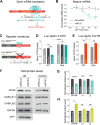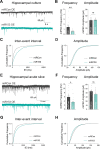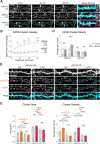This is a preprint.
miRNA-mediated control of gephyrin synthesis drives sustained inhibitory synaptic plasticity
- PMID: 38168421
- PMCID: PMC10760056
- DOI: 10.1101/2023.12.12.570420
miRNA-mediated control of gephyrin synthesis drives sustained inhibitory synaptic plasticity
Update in
-
miRNA-mediated control of gephyrin synthesis drives sustained inhibitory synaptic plasticity.EMBO Rep. 2024 Nov;25(11):5141-5168. doi: 10.1038/s44319-024-00253-z. Epub 2024 Sep 18. EMBO Rep. 2024. PMID: 39294503 Free PMC article.
Abstract
Activity-dependent protein synthesis is crucial for many long-lasting forms of synaptic plasticity. However, our understanding of the translational mechanisms controlling inhibitory synapses is limited. One distinct form of inhibitory long-term potentiation (iLTP) enhances postsynaptic clusters of GABAARs and the primary inhibitory scaffold, gephyrin, to promote sustained synaptic strengthening. While we previously found that persistent iLTP requires mRNA translation, the precise mechanisms controlling gephyrin translation during this process remain unknown. Here, we identify miR153 as a novel regulator of Gphn mRNA translation which controls gephyrin protein levels and synaptic clustering, ultimately impacting GABAergic synaptic structure and function. We find that iLTP induction downregulates miR153, reversing its translational suppression of Gphn mRNA and allowing for increased de novo gephyrin protein synthesis and synaptic clustering during iLTP. Finally, we find that reduced miR153 expression during iLTP is driven by an excitation-transcription coupling pathway involving calcineurin, NFAT and HDACs, which also controls the miRNA-dependent upregulation of GABAARs. Overall, this work delineates a miRNA-dependent post-transcriptional mechanism that controls the expression of the key synaptic scaffold, gephyrin, and may converge with parallel miRNA pathways to coordinate gene upregulation to maintain inhibitory synaptic plasticity.
Figures






References
-
- Martin KC, Casadio A, Zhu H, Yaping E, Rose JC, Chen M, Bailey CH, Kandel ER. Synapse-specific, long-term facilitation of aplysia sensory to motor synapses: a function for local protein synthesis in memory storage. Cell. 1997. Dec 26;91(7):927–38. doi: 10.1016/s0092-8674(00)80484-5. PMID: 9428516. - DOI - PubMed
-
- Gal-Ben-Ari S, Kenney JW, Ounalla-Saad H, Taha E, David O, Levitan D, Gildish I, Panja D, Pai B, Wibrand K, Simpson TI, Proud CG, Bramham CR, Armstrong JD, Rosenblum K. Consolidation and translation regulation. Learn Mem. 2012. Aug 16;19(9):410–22. doi: 10.1101/lm.026849.112. PMID: 22904372; PMCID: PMC3418764. - DOI - PMC - PubMed
Publication types
Grants and funding
LinkOut - more resources
Full Text Sources
